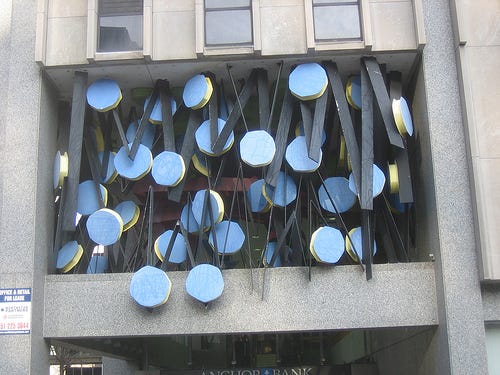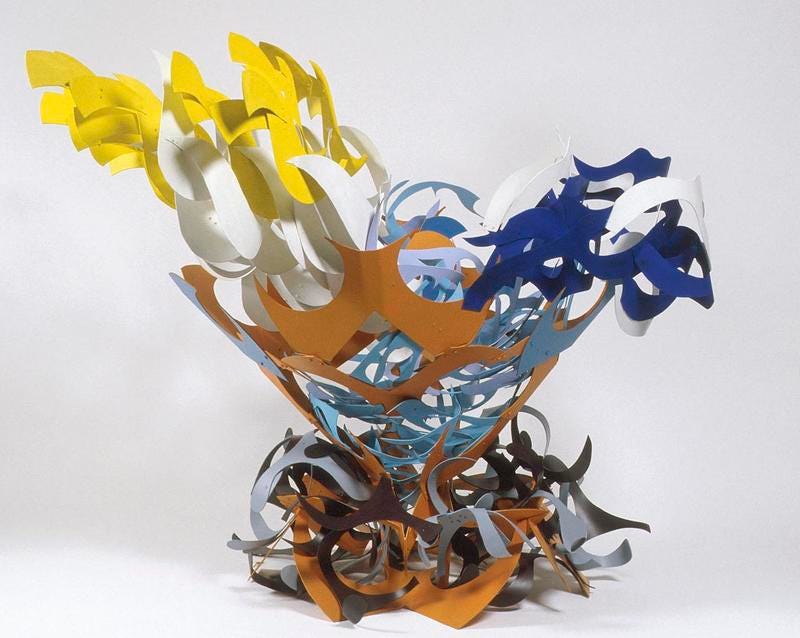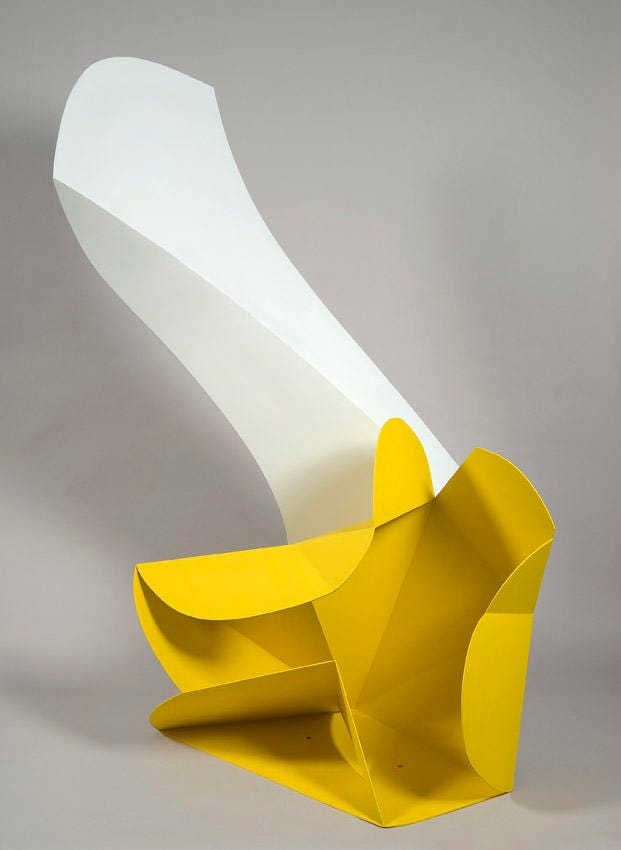This is the first of what I hope will be a series of posts about lesser known artists whose work I love. George Sugarman (1912-1999) was an American sculptor. Readers of this newsletter and the blog that preceded it, also titled The Great God Pan is Dead knows that I became mildly fascinated with Sugarman’s sculpture when I started discovering pieces of a huge sculpture he made for a bank in St. Paul, Minnesota, variously called Saint Paul Sculptural Complex or Saint Paul Commission. It was made in 1971 as a site-specific piece for the First National Bank of St. Paul.
This is what the St. Paul Commission looked like from the outside. (This photo is by Kevin Hendricks and was taken without permission from his Flickr stream. Mr. Hendricks, let me know if I can use it, please.)
This is an interior view. (Another Kevin Hendricks photo, used without permission.)
This photo is from the website of Lippincott Sculpture, a firm that specializes in fabricating large sculptures, particularly out of metal. (The man in the foreground is Sugarman.) Their website is well-worth looking at. They’ve made sculptures for an amazing number or artists, including Houston favorite Mark di Suvero (I wonder if his sculptures at the Menil or at Rice University were fabricated by Lippincott?)
The story of how this sculpture was dismantled and moved to various locations in Houston and Austin was told in an article for the Houston Chronicle by Dougas Britt. Basically, a huge commercial real estate firm called Grubb & Ellis bought the sculpture (which was going to be discarded by the new owner of the bank building in St. Paul) and decided to use the pieces to decorate some of its properties. Grubb & Ellis declared chapter 11 bankruptcy in 2012. The bankrupt Grubb & Ellis was acquired by BGC Partners in 2012, so the various parts of Sugarman’s sculpture are presumably now owned by them.
This is a segment of the sculpture in Austin
This segment was in front of a building 602 Sawyer in 2009, but I haven’t checked recently.
This bit is behind a building in Montrose on Hyde Park.
Seeing all these bits and more of Sugarman’s huge piece scattered hither and yon makes me wonder if BGC has kept track of them all. Is there a St. Paul Commission database? The various peices I’ve seen don’t seem to be in great condition, so conservation is not a priority. It begs the question: could the St. Paul Commission be reassembled? It’s a project I sometimes fantasize about. Obviously it can’t be returned to its original condition, as it was site specific to the First National Bank in St. Paul. And the original was enormous, so reconstituting it would require warehouse space for all the parts and a very large workshop.
The only other Sugarman I’ve ever seen in person is One, pictured above. It’s at Storm King, the enormous sculpture park about an hour north of New York City. It’s made of painted aluminum, and was created in 1975-77. What distinguishes Sugarman from his peers (like di Suvero, Louise Nevelson, Tony Smith, etc.) is that his work was polychrome. All the pieces I’ve seen in person or in photos are painted in multiple colors. And in addition, they’re busy—they have a lot of parts fitted together. They employ the same kinds of materials as the minimalists did, but are the opposite of minimal. This might be why Sugarman is not as well known as, say, Joel Schapiro or Carl Andre. His work just doesn’t fit into the narrative of postwar art that has eventually become canon.
Aside from the scraps of the St. Paul Commission, can we Texans see any of Sugarman’s sculpture? Not in Houston. The Museum of Fine Arts has one Sugarman, but it is a silkscreen print. Neither the Menil nor the Dallas Museum of Art nor tthe Fort Worth Modern have any George Sugarmans. But the Blanton in Austin and the McNay in San Antonio have Sugarman sculptures in their collection.
This is Two In One, owned by the Blanton Museum. It is from 1966, and is a polychromed wood installation of nineteen elements. I’ve been to the Blanton many times, but I don’t recall seeing this mammoth piece on display. But they have it! And one can see colors and shapes that recall the much larger St. Paul Commission. They also have a smaller Sugarman sculpture called Two Reds and a Blue (1961).
It is also made of wood and is only 56 inches on its longest axis.
The McNay Museum in San Antonio also has several Sugarman sculptures. I’ve been to the McNay but I son’t recall seeing them on display.
This is Orange Around from 1978. Unlike the two wood sculptures at the Blanton, this 1978 sculpture is made of painted aluminum, as was One at Storm King. This leads me to believe that Sugarman started working in aluminum is the 70s after gaining a certain mastery of producing work in wood early in his career. The aluminum allowed him to create windblown works like One and Orange Around, which I believe would have been difficult to achieve with wood.
This one is untitled from 1965. Sugarman was still working with wood then, but the shapes are unmistakably his.
This is another untitled piece. It’s from 1995, shortly before Sugarman’s death. He is using painted aluminum, as was charactristic in his later work, but it doesn’t have the same curvy, windblown feel as One or Orange Around or maximalist jumble of the St. Paul Commission. I can’t say whether this represented a change in direction for him because I’m not familiar with his entire body of work over time. But maybe?
This makes me want to do a Texas Sugarman tour, which would involve road trips to Austin and San Antonio to see these sculptures up close. But they would have to be on display, which is not guaranteed.
I’m not in charge of art history, so I can’t will George Sugerman to have a larger part in it. He had success during his life, with museums collecting his work and getting large private commissions. That kind of success might be the best an artist can hope for—they have no conttol of their work after they die. But it does seem especially ignomious to have ones largest work dismantled and used at coporate decoration, as Grubb & Ellis did.
[Please consider supporting my work by becoming a patron.]















